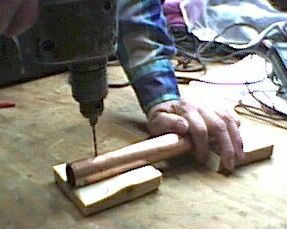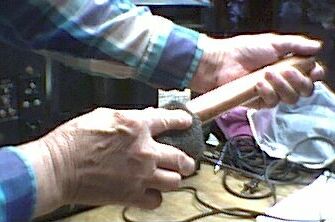 |
 |
 |
 |
 |
 |
 |
 |
 |
 |
 |
 |
 |
 |
 |
 |
 |
 |
 |
 |
 |
 |
 |
 |
 |
 |
 |
 |
 |
 |
 |
 |
 |
 |
 |
 |
 |
 |
 |
 |
 |
|
|
Drilling a Pipe To Make Wind Chimes |
|
|
|
by Jim Haworth |
|
|
|
Drilling a chime with a hand-held power tool can be tricky because the running drill bit tends to skitter off the round pipe. If you use a nail or center punch to first put a dimple in the pipe, the drill bit will be held where you want it until it penetrates the pipe. A center punch (Picture 7) has a sharp point and is struck with a hammer to produce the dimple. Practice on a scrap pipe first. If you hit the punch or nail too hard the pipe will be flattened slightly and soft metals like aluminum and copper deform easily. Learn how it hit it just hard enough to leave a barely discernible dimple without leaving a flat spot which will show on the finished chime (Picture 8). Place the drill bit into the dimple, them start the drill, using very light pressure until the bit goes into the metal a little ways, when more pressure may be applied (Picture 9). When the bit is completely through the first wall of the pipe just be sure the drill is held straight and continue drilling until the other side is penetrated. |
|
|
|
 |
|
|
 |
|
|
|
|
|
 |
|
|
|
|
|
Picture 7 |
|
|
|
|
|
|
|
|
|
|
Picture 8 |
|
|
|
Picture 9 |
|
|
|
|
|
The holes drilled in the sides of the chime will have burrs that will quickly cut the strings or monofilament used to suspend them. The first hole will have the burr on the inside and can be removed with a file or sandpaper. If you continued through to drill the second hole, the hole will have the burr on the outside of the chime. You should not use a file or sandpaper as they will leave deep scratches around the hole and will mar the appearance of the chime. Use only fine steel wool to remove the burr (Picture 10) . Fine steel wool can be purchased at any hardware store or home building center. A steel wool pad like Brillo can be used also. |
|
|
|
 |
|
|
|
Picture 10- steel wool |
|
|
|
If you prefer not to use a center punch, you can still drill into the chime. With the drill running, just lightly touch the pipe with the spinning bit, then withdraw it slightly, then touch lightly again. When a dimple is created, press the drill a little harder until the bit penetrates the side of the pipe. |
|
|
|
You may want to make cradles to steady the pipes as you drill them. Cut two by fours into four inch pieces. Drill holes completely through with a one inch wood bit while holding them in a vise (Picture11) . Use a hatchet to carefully split the wood in the middle of the hole (Picture 12) . |
|
|
|
 |
|
|
|
 |
|
|
|
|
|
Picture 11- 1" spade bit |
|
Picture 12 - use scrap wood under block to prevent dulling hatchet blade |
|
|
|
|
|

|
|
|
|
http://www.oocities.org/teeley2/chimeart.html Return to chime making article |
|
|
|













